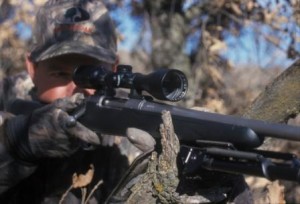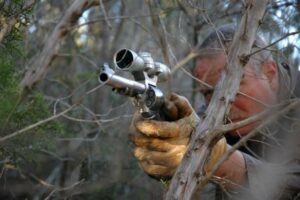 To have a blast shooting targets and hunting every species of game bird and animal across America, you only need 5 firearms.
To have a blast shooting targets and hunting every species of game bird and animal across America, you only need 5 firearms.
.22 Long Rifle (LG)
Every man, woman and child on Earth needs a good old .22, whether for plinking paper or potting a mess of squirrels in October. It’s the rifle that most of us grew up with. The one you need to get into your kid’s hands as soon as he or she is ready to join our shooting fraternity.
Quiet to shoot and with no recoil, a rimfire rifle is the perfect tool for young or new shooters. For those of you who have been hunting awhile, think of a .22 as the perfect understudy for your deer rifle. You can go to the range several times a year and comfortably shoot a scoped .22 rifle all day long to fine-tune your sight picture, breathing, alignment and trigger control. There’s no better practice for the upcoming whitetail season, I don’t care how experienced you are.
The .22LR has long been the most popular cartridge in America, and today’s rimfire rifles are of the best quality yet. No matter your preference or budget, there’s a sweeting-shooting bolt-action or autoloader for you.
Bolt-Action Deer Rifle
I could write for days about deer rifles, but here I’ll simplify things: Any centerfire rifle that shoots a 140- to a 180-grain bullet accurately out to 250-300 yards is a good choice for hunting any species of deer anywhere in North America.
Five calibers you should consider: .270, .308, 7mm-08, .30-06 and 7mm Rem. Mag. There are many more adequate cartridges out there and new rounds popping up every so often, but go with one of the aforementioned and proven 5 and you’ll be happy.
I have 3 favorites:
- .270: As hunting cartridges go, the .270 is a plenty accurate round with manageable recoil; no question, the less “kick” of a rifle, the better people shoot and hunt with it. While the perfect caliber for whitetails, the .270 with a 140-grain bullet is fine if you get a hankering to go West for mule deer.
- 7mm-08: Overlooked by too many hunters, this round is accurate, easy-to-shoot and has minimal recoil. The 7mm-08 is an especially good choice for young hunters and women. I use mine to hunt Texas whitetails every year.
- If you want more firepower and can handle more recoil, you can’t go wrong with the time-proven .30-06. If you choose a bolt-action that fits you well and feels comfortable and snug on your shoulder and cheek, the recoil of an ’06 actually isn’t that bad. A thumper for whitetails and muleys; move up to the 180-grain bullet and you can hunt every hoofed mammal in North America, including elk and moose.
While some rifles will shoot better than others right out of the box, any new bolt gun you purchase will be more than accurate enough for deer hunting. All you really need is a rifle/scope/ammo combo that will shoot a 3-shot group that measures 2 inches or less at 100 yards. That’s a bar easy to meet, and most .30-06 rifles with good scopes shoot better.
Final thoughts: Barrels on today’s hunting rifles are typically 22 or 24 inches, either is fine. Lightweight synthetic stocks are tough, look okay and shed rain. Many rifles come from the factory with trigger pulls of 5 pounds or more. You will shoot better with a crisp-breaking, 3 ½- to 4-pound trigger. Have a qualified guy at your gun shop measure the trigger and lighten the pull if necessary.
Shotgun
“Bird Gun” is our Southern term for a wood-stocked, lightweight, sweet-handling, 12- or 20-gauge shotgun that is perfect for breaking clay pigeons or shooting a limit of quail, doves or pheasants.
We’re talking semi-auto or over/under chambered for 2 3/4-inch shells (typically No. 7 1/2 to 9 shot), with a 24- to 26-inch barrel fitted with chokes tubes. Skeet, Improved Cylinder and Modified are the top tubes you’ll need and use.
A bird gun is the cream of the crop of this collection, and will run you $1,000 to $2,000 or a bit more. Shop around and check out the used gun rack at your local gun shop. Think of it as a lifelong investment, a gun you can pass along to one of your kids.
Bottom line, you need a fine shotgun to get the most enjoyment out of your wing-shooting, be it for clay pigeons or live feathers.
Either 12- or 20-gauge is okay. If you’ll shoot mostly skeet and clays, I’d recommend a 20. If you’ll hunt a lot of doves, grouse and heavier pheasants, I’d go with a 12-gauge.
You could screw a Full Choke tube into your bird gun and use it to kill a turkey or a limit of mallards—I’ve done that a bunch of times–but there is a better choice of gun for that.
Magnum Shotgun
While not a gun you’ll shoot every month, you need a heavy-duty 12-gauge magnum for your arsenal. It’s the ticket for turkey hunting in the spring, and a workhorse for shooting ducks and geese in fall and winter.
Your choice of pump or semi-auto, chambered for 3- and 3 ½-inch shotshells and cloaked in camo of course. If you’ll hunt mostly waterfowl, go with a 26- or 28-inch barrel. While that same barrel will work fine for gobblers, many of today’s specialty turkey guns have 21- or 22-inch barrels, which are easier to carry and maneuver in the woods. A variety of choke tubes for either steel or turkey loads are available in any gun you choose.
Handgun
I’ve been shooting a lot of handguns lately, mostly for the fun of it. But it is not lost on me that crime is surging in many parts of the country. I want to be proficient with a pistol and ready to protect my family and property, and you should be too.
For ease of use and dependability, you can’t beat a double-action revolver. Load up, aim at the target and pull the trigger 5 or 6 times until the gun is empty.
There are many makes and sizes of revolvers on the market, from little stub-nose guns to huge “hog legs” like Wayne and Eastwood famously used to save the day in western movies. Do your research. For most people, a mid-size revolver with a 5- or 6-inch barrel is about right. Heavy enough to absorb recoil, but light enough to aim and hold steady on target.
Caliber-wise, you can’t go wrong with a .38 or .357.
I started out with revolvers and still use them, but these days I do most of my shooting with a semi-auto handgun.
The semi has 3 advantages over the revolver: less recoil, typically a better trigger, and more fun to shoot. A day at the range, running 10- to 13-shot magazines through a semi-auto, is pure ecstasy for a gun nut like me.
A semi-auto does require more thorough cleanings than a revolver, but I look at that as a good thing. It makes you learn your weapon—how to dissemble it, clean it and reassemble it after every shooting session. You come to know your weapon and feel confident and safe with it.
Again, do your research online and at the gun shop. There are many makes, sizes and calibers of semi-autos to choose from. A big consideration: Many of these handguns have thumb safeties, while some have no safety. Think about that and go with one you feel most comfortable with.
For most of you, my current arsenal of semi-autos is a good guideline. I shoot a full-size .45 double-stack Glock that measures 7½ from rear of slide to the muzzle. My wife shoots a smaller, lighter version of the same gun in 9mm. There are other calibers, but love the .45 and 9mm!






